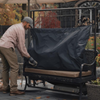The Dos and Don'ts of Closing Your Pool This Fall
- by Jordan Rhodes
Closing your lovely pool this coming fall seems like an easy task to accomplish, right? Well, the truth is, it's not as simple as opening and closing a ziplock; you need to do certain steps and proper upkeep to make sure you can still enjoy your swimming pool the way you used to love it after the fall and off-season.
No damage, no dirty algae buildup, no pile of debris like leaves or dead animals—but how can you ensure you’re doing it the right way? Here are some things you should and should not do:

The Dos:
Test and Balance Your Pool Water
Before closing your pool, it's important to test and balance the water's chemistry. Test the pH, alkalinity, calcium hardness, and sanitizer levels. Make adjustments as needed to bring all levels into the ideal ranges.
Balanced water will prevent problems like corrosion, scaling, and algae growth while the pool is closed. Provide your pool store with the test results, and they can recommend the proper closing chemicals.
Shock the Pool
Shocking your pool before closing kills any remaining algae and bacteria, providing a clean slate for the spring opening. Using a strong triple-action shock at 3-5 times the normal dose ensures a thorough cleansing. Allow the shock to circulate for 24 hours before moving forward with additional closing steps.
Clean the Pool
Remove any debris from the bottom with a vacuum. Use a pool brush attached to a telepole to scrub the walls and floor. Check the sides, steps, and corners for black algae and clean thoroughly if any are found. Removing organic matter prevents it from causing issues while the pool is closed.
Lubricate the Pump Seal
The pump seal is susceptible to drying out over the long off-season months if left unprotected. Take the time to properly lubricate the seal before closing to prevent damage.
Carefully clean around the pump seal area to remove any dirt or debris. Apply a small bead of lubricant, like silicone oil or vegetable oil, directly to the seal. Use your finger to gently spread the lubricant evenly around the seal, covering both stationary and rotating faces.
The lubricant provides a protective coating that prevents the rubber from drying, cracking, or adhering to the seal plate. Without lubrication, a dried-out seal will leak next spring and potentially freeze, requiring expensive repairs. Lubricating provides an added layer of protection.
Add Pool Closing Chemicals
After shocking, balancing, and cleaning the pool, add specialty closing chemicals per the manufacturer’s instructions. Algaecides prevent algae growth, while winterizers protect plumbing and equipment from freeze damage. Metal inhibitors prevent corrosion and staining. Combination winterizing kits are available for convenience.
Drain All Water From Plumbing
Ensuring water is drained from plumbing and equipment is important to prevent freeze damage over the winter. Make sure to thoroughly drain all water from the pumps, pipes, filters, and other equipment first, as water left sitting in components all winter can freeze, expand, and cause cracks or leaks.
Then open hose bibs, the pressure release valve, the filter housing, pumps, heaters, and chlorinators. Use a wet or dry vacuum to remove any remaining water from pipes and fittings. But, unless specifically recommended for your climate, don’t completely drain your pool.
Disconnect and Store Hoses
Unhook all hoses from equipment like filters and pumps. Allow them to completely drain and dry before loosely coiling them and storing them indoors. Check fittings and hose bibs for cracks or leaks, and replace as needed. Storing hoses prevents damage from freezing temperatures.
Winterize Above-Ground Pools
For above-ground pools, remove the skimmer and filter hoses. Plug up the holes in the pool wall to prevent critters from getting inside. Remove and store pool ladders and handrails. Check the liner for leaks and patch any small holes.
Cover the Pool Securely
Invest in a quality winter pool cover to seal in closing chemicals and provide an extra barrier against winter debris and pests. Solid covers should have water tubes to weigh them down. Mesh covers should have a cable system with winches to keep them secure and tight to the pool.
Don't use regular tarps, as plastic tarps or sheeting are not safe substitutes for a real quality pool cover. They easily collect standing water, snow, leaves, and debris, which leads to cover collapse. Invest in a fitted cover designed for pool use.
Brands like Kafko™ offer in-ground and above-ground pool covers that are meticulously engineered to provide the best protection for your swimming pool.
The Don'ts:
Completely Disconnect Power to Equipment
If you think turning off your pool's electrical system will save you money on electricity bills, think again! Completely disconnecting power can actually cost you more in the long run. Instead, leave the power connected to the circulation and sanitation systems for the winter.
Program the pump timer to run briefly for 30–60 minutes once or twice per week. Allowing the water to circulate prevents stagnation and reduces the amount of spring start-up work needed. The small amount of electricity used is worth it.
Running the circulation on occasional short cycles will prevent water from becoming stagnant while using very minimal electricity. At the same time, you eliminate the risk of frozen plumbing and equipment damage that could cost you thousands in repairs. The small upfront cost is worth avoiding huge expenses down the road.
Closing Early
Don’t rush to close your pool as soon as summer ends. Determining the right time to close requires paying attention to current and forecasted weather conditions. Ideally, wait until daytime high temperatures are consistently around 60-70 degrees Fahrenheit.
Closing too early while temperatures remain warm runs the risk of algae blooms and other issues. The warm sun will heat up the stagnant pool water, creating the perfect conditions for algae growth without proper circulation.
On the other hand, closing too late leaves your pool unprotected and vulnerable to environmental debris like falling leaves, dirt, and dust. For most regions, late September to early October is ideal.
Forget About Fall Care
After closing, don’t abandon your pool until spring. Visit it periodically to check water levels, remove debris, and make sure the cover remains secure. If the cover deteriorates or blows off, replace it immediately to avoid safety issues and winter damage.
Closing your pool properly in the fall will pay off when opening day arrives next spring. Following these do's and don'ts will protect your pool all winter for easier opening and fewer repairs. With the right preparation, your pool will be sparkling clean and ready for another summer season.
That’s it! Now you know the dos and don'ts you should keep in mind when closing your swimming pool this fall. Sounds like a lot of work? Why not let the experienced professionals at Krevco Lifestyles help?
From swimming pool openings and closings to resurfacing, liners, and complete swimming pool maintenance, we are your number one choice to get the job done, and we get the job right. Schedule a date today!





